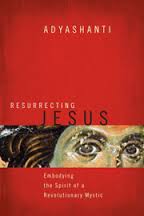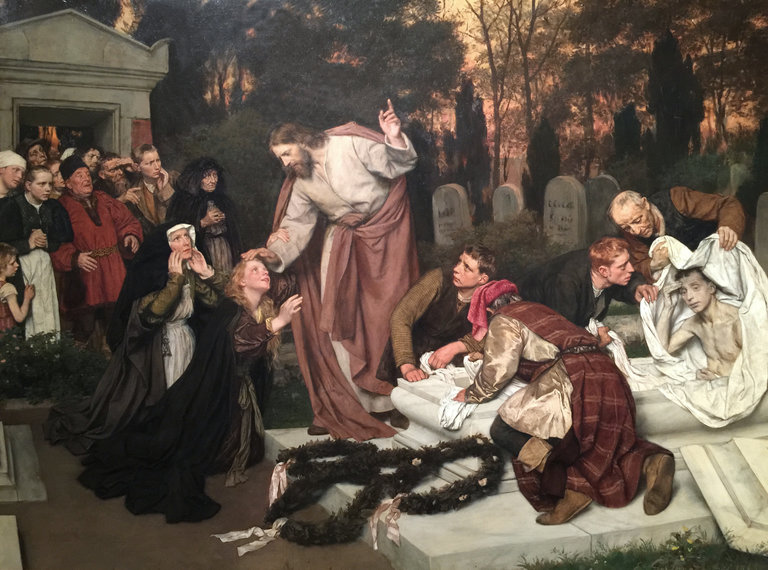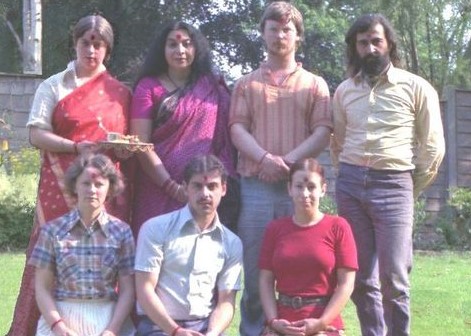“What I found in the story (of Jesus) was an incredibly revolutionary figure.”

“Like many people, my sense of who Jesus was was primarily informed by the prevailing culture. The Jesus that I knew was really the Jesus I saw on TV and in movies, the Jesus depicted from the pulpit, and later the Jesus that I found when I studied the mystics, which was a mystical Jesus. These were the faces of Jesus that I had gotten to know through the first thirty-five years of my life. It may look strange, but even through all my study of the Christian mystics I had never actually sat down and read the four Gospels. I never really read through the biblical story of Jesus. And when I did, I was amazed, even stunned by what I found.” Adyashanti
THE JESUS OF THE GOSPELS
“Jesus said, 'I have cast fire upon the world,
and see, I am guarding it until it blazes.' GOSPEL OF THOMAS
Now let's fast-forward a dozen years. My Zen teacher had at this point asked me to teach, and I began sharing the dharma—giving talks, having retreats, following the trajectory of a contemporary spiritual teacher. I have never felt like it was my aim as a teacher to spread Buddhism, and in fact my teacher didn't even ask me to try to do that. What attracted me to spirituality at the very beginning-the question, "What is enlightenment?”-is what I'm primarily interested in as a teacher and what I'm there to awaken in the hearts and minds of the people who come to be with me.
In the course of my teaching, I discovered that whenever I talk about the Jesus story, it tends to resonate with people. That's not surprising, because the Western mind has been dominated by Christianity for more than two thousand years, so whether you're Jewish, Buddhist, Muslim, or even atheist, you can't help but be impacted by this story. This fact alone makes the story worthy of re-examining, and in doing so, we might find that the Jesus we've been told about is very different from the Jesus in the Gospels. That's what I hope to investigate.
Reading the Good News
Like many people, my sense of who Jesus was was primarily informed by the prevailing culture. The Jesus that I knew was really the Jesus I saw on TV and in movies, the Jesus depicted from the pulpit, and later the Jesus that I found when I studied the mystics, which was a mystical Jesus. These were the faces of Jesus that I had gotten to know through the first thirty-five years of my life. It may look strange, but even through all my study of the Christian mystics. I had never actually sat down and read the four Gospels. I never really read through the biblical story of Jesus. And when I did, I was amazed, even stunned by what I found.
The Jesus that I found in the Gospels wasn't like the Jesus that I had absorbed through my culture or even the Jesus brought to life by the mystics. What I found in the story was an incredibly revolutionary figure, someone who broke down barriers and lines of separation, whether in the culture at large, in the political arena, or in the religion that he was brought up in. When I read the Gospels, something in me deeply connected with Jesus the revolutionary mystic, the one who is actually courageous enough to move through life guided and inspired by the dynamic of his spiritual essence. Seeing Jesus through the lens of the spiritual revolutionary is powerfully transformative; if we can embody that spirit within ourselves, we can begin to break down the internal walls that separate ourselves from each other, from the world, and from our own divinity.
There are many lenses through which to view the Jesus story. Jesus the revolutionary is, I believe, one of the most powerful lenses for our contemporary spiritual culture. Our contemporary culture and religion needs an influx of new life. I think the churches in this country need to be revitalized; they need that challenging presence of Jesus that says, "it's important that you realize the truth of your being. There are profound consequences to living in darkness.” As Jesus says in the Gospel of Thomas, "If you do not bring forth what is within you, what you do not bring forth will destroy you.” [Gospel of Thomas 70].”
Resurrecting Jesus: Embodying the Spirit of a Revolutionary Mystic
Adyashanti, Sounds True, 2014, pp. 15-17
Resurrecting Jesus
Embodying the Spirit of a Revolutionary Mystic
“The story of Jesus has not waned in its power to change lives. Yet today, even though the majority of us grew up in a culture suffused by the mythos of Jesus, many of us feel disconnected from the essence and vitality of his teachings. With Resurrecting Jesus, Adyashanti invites us to rediscover the life and teachings of Jesus as a direct path to what may be the most radical of transformations: spiritual awakening.
Jesus crossed all of the boundary lines that separated the people of his time because he viewed the world from the perspective of what unites us, not what divides us. In Resurrecting Jesus, Adyashanti asks us to consider the man known as Jesus as an exemplar of the realized state and a model of enlightened engagement with the world. He examines the story of Jesus from his birth to the Resurrection to reveal how the central events in Jesus' life parallel the stages of awakening that we may be called to experience ourselves. Adyashanti then illuminates five central archetypes of the Jesus story—Peter, John, Mary Magdalene, Judas, and Pontius Pilate—and the key insights they hold about the way we may relate to the spiritual impulse within.
'When the eternal and the human meet,' writes Adyashanti, 'that's where love is born—not through escaping our humanity or trying to disappear into transcendence, but through finding that place where they come into union.' Resurrecting Jesus is a book for realizing this union in your own life, from one moment to the next, with heart and mind wide open to the mystery that lives inside us all.”
http://www.adyashanti.org/index
Web (December 23, 2014)
Amazon.com Customer Reviews
Review of Resurrecting Jesus
By Gina Lake on April 8, 2014
“I really enjoyed this book. I listened to it on audiobook. As a teacher myself and lover of Jesus, I was fascinated to hear what Adyashanti, a truly wonderful and clear nondual teacher, had to say about Jesus and his life. Adyashanti beautifully and eloquently explained the metaphorical meaning of the Jesus story and how Jesus's life symbolized the journey of awakening and enlightenment. Throughout the book, Adya deftly wove his understanding of Jesus's teachings and the Jesus story with what Adya himself has been teaching these many years, tying the teachings of Christ with present-day nondual teachings, as only someone like Adya could do. I was impressed with Adya's knowledge of the gospels and, most of all, with the love he has for Jesus and the Christian mystics. Adya's own heart was very apparent in this book. If you are interested in this subject, you will not be disappointed. Adya was courageous in tackling this subject, but his interest in Jesus has obviously been lifelong and passionate enough to make him just the right instrument for it.”
A fresh, new look at Jesus, the revolutionary mystic
By Yana E. Murphy on May 17, 2014
“'Resurrecting Jesus' is not, and may never be, sanctioned by the RC Church. It is, however, a deep look at 'the Jesus story' from an American (Californian!) Zen practitioner who is himself, by all indications, 'awakened'.
Adyashanti describes the awakened state as something completely within reach for each of us. He sees Jesus as both human and divine (awakened) whose divinity took root during his baptism by John, the one who lived 'on the fringe of society.'
What I found refreshing as the story itself is how Adyashanti weaves us into it, suggesting that 'until we pour ourselves into the story, until we become the story in ourselves, in our blood, flesh, and bones, it doesn't fully come alive.' At the end, he looks at five main characters/archetypes, besides Jesus, who exemplify personalities and 'the spiritual impulse' that we can relate to: Peter, John, Judas, Pontius Pilate, and Mary Magdalene.
'Life is this simple: we are living in a world
that is absolutely transparent and the divine
is shining through it all the time. This is not
just a nice story or a fable, it is true.' Thomas Merton
The same is true for this book.”
I recommend to those who are seeking truth, not religious dogma. By Sally S. on July 22, 2014
“I found the book to be an awakening experience. I was brought up with religious dogma as the center of my life. I was continually questioning the teachings of the church and even as a child challenged the interpretations. I have read the bible from front to back more than once seeking truth. But it never aligned with my core being when I used the church's interpretations. After reading Resurrecting Jesus and studying other religions I am free of the dogma and feel comfortable with my own understanding and belief in what this life is all about.”
http://www.amazon.com/Resurrecting-Jesus-Embodying-Spirit-Revolutionary/dp/162203094X
Web (December 22, 2014)
"There is something new and startling in both his person and his teaching that defies the categories provided by the world and culture in which he lived.”

“A Christian view of culture and human history, which are intimately linked, looks to creation and the role of a creating God. At the center of the life and teaching of Jesus of Nazareth stand his convictions about the reigning presence of God as creator and Sovereign. This is most evident in his teaching through the parables of the kingdom.
The Parables and the Kingdom
The notion of God as sovereign over the whole of creation, and especially in the divine role at the center of God's human creation, was found in the Old Testament (see, for example, Pss 22:28; 45:6; 103:19; 145:11-13; Dan 4:3, 34; 1 Chr 17:14; 29:11). The creator God made all things perfectly (see especially Gen 1:1-2:4). As creator, however, YHWH also saves, judges, and loves a people with whom he has forged a covenant. Thus the Old Testament notion of God as Sovereign also carried with it the idea of an end-time, a 'day of the Lord' that would spell the end of human history and the final manifestation of God's rule (see, for example, Isa 2:2-4, 24-27; 24:21-23, 32:22; 52:7-10; Micah 2:12-13; 4:1-7; Obadiah 21, Zechariah 9-14).
Jesus uses the term to refer to a future decisive intervention of God into the affairs of men and women, where the false values of the world would be reversed and the values of God established (see, for example, Matt 5:3-12//Luke 6:20-23). He used the traditional symbols, such as the 'messianic banquet,' to express this idea (see especially Matt 8:11; the same symbolism may be behind John 2:1-11). He also spoke of a final blessed state into which the redeemed would 'enter,' which they would 'inherit' or 'receive' at some point in the future (se, for example, Mark 9:47; 10:14-15, 23-25; Matt 5:20; 7:21; 21:31). Such a usage can be explained in terms of Israel's idea of God as sovereign, and especially in terms of the apocalyptic use of the expression 'Kingdom of God' which, although rare, is to be found in the Judaism of the time of Jesus. Such background, however, cannot explain the person and teaching of Jesus. There is something new and startling in both his person and his teaching that defies the categories provided by the world and culture in which he lived. It is clearest in all its radical nature in Jesus' insistence that in his person and activity God's decisive intervention was already present: 'But if it is by the finger of God that I cast out the demons, then the Kingdom of God has come to you (Luke 11:20//Matt 12:28.' While there are other isolated sayings of Jesus that are similarly significant in this regard (see especially Matt 11:12-14 and Luke 17:20-21), contemporary parable study is showing with increasing clarity that in Jesus of Nazareth the ways of God were being reestablished.”
A Hard Saying: The Gospel and Culture
Francis J. Moloney, Michael Glazier (July 1, 2001) p. 186-7

"The Raising of Lazarus" by Eduard von Gebhardt, from 1896. Credit Corbis, via Getty Images “Consider that Jesus was incarnated in a human body. He was a child in need of care and protection. He was a carpenter, a craftsman who worked creatively with his hands. His first miracle was at the wedding in Cana, where he transformed water into wine. There was joy and purpose to be found in the commonplace. The Incarnation also bestowed worth on people considered contemptible, unessential and valueless — "the least of these," as Jesus put it.
Indeed, one of the indictments of him by the religious authorities of his day was that he was a "friend of sinners.” Jesus' love was "undiscriminating and inclusive," according to the writer Garry Wills, "not gradated and exclusive.” He spent most of his time with those who were forsaken, poor, powerless and considered unclean. In a patriarchal society, Jesus gave women an honored place. He not only associated with them, but they were among his disciples, the object of his public praise, the first people he spoke to after his resurrection.
The most intense confrontations Jesus had weren't with those with loose morals but with religious leaders, the upholders of the "holiness code" whom he called out for their arrogance, hypocrisy and lack of mercy. In the Temple courts, Jesus told the chief priests, "I tell you the truth, the tax collectors and the prostitutes are entering the kingdom of God ahead of you.” In the words of Professor Wills, "He walks through social barriers and taboos as if they were cobwebs.”"
New York Times, 24 December 2016
The Love that the Paraclete Jesus taught about is an energy field in which to live, a state of non-dual consciousness in which one passes out of death into life.”
‘You have heard that it was said, ’You shall love your neighbour and hate your enemy.’ But I say to you, Love your enemies and pray for those who persecute you, so that you may be sons of your Father who is in heaven. For he makes his sun rise on the evil and on the good, and sends rain on the just and on the unjust.’ (Jesus Christ - Matthew 5:43-45)
‘Truly, truly, I say to you, he who hears My word, and believes Him who sent Me, has eternal life, and does not come into judgment, but has passed out of death into life.’ (Jesus Christ ’ John 5:24)
‘I am the true vine, and My Father is the vine-dresser’ Abide in Me, and I in you. As the branch cannot bear fruit of itself, unless it abides in the vine, so neither can you, unless you abide in Me. I am the vine, you are the branches; he who abides in Me, and I in him, he bears much fruit; for apart from Me you can do nothing.’ (Jesus Christ - John 15: 1, 4, 5)
‘Truly, truly, I say to you, he who believes in Me, the works that I do shall he do also; and greater works than these shall he do; because I go to the Father.’ (Jesus Christ ’ John 14:16-17)

“... Jesus taught a way of being that involved profound personal change which centered on what we have to render in English by the poverty-stricken word ‘love.’ All of his mandates as to how we should live and behave were signposts to keep us in that state, or were realities that we would notice in a person who was living in that state. They were never intended as imperatives to be obeyed, for which we would get a ’reward,’ and for which, if we did not obey, we would be punished later. In the teaching of Jesus ’Love’ is not a virtue to be practiced, but an energy field in which to live.’ Jesus was a Master whose message was based on acquiring a state of non-dual consciousness.’”
Miceal Ledwith, Saving Jesus, Introduction
Edessa Code (2017) p. 19

"The Paraclete will come (15:26; 16:7, 8, 13) as Jesus has come into the world (5:43; 16:28; 18:37)... The Paraclete will take the things of Christ (the things that are mine, ek tou emou) and declare them (16:14-15). Bishop Fison describes the humility of the Spirit, 'The true Holy Spirit of God does not advertise Herself: She effaces Herself and advertises Jesus.' ...
It is by the outgoing activity of the Spirit that the divine life communicates itself in and to the creation. The Spirit is God-in-relations. The Paraclete is the divine self-expression which will be and abide with you, and be in you (14:16-17). The Spirit's work is described in terms of utterance: teach you, didasko (14:26), remind you, hypomimnesko (14:26), testify, martyro (15:26), prove wrong, elencho (16:8), guide into truth, hodego (16:13), speak, laleo (16:13, twice), declare, anangello (16:13, 14, 15). The johannine terms describe verbal actions which intend a response in others who will receive (lambano), see (theoreo), or know (ginosko) the Spirit. Such speech-terms link the Spirit with the divine Word. The Spirit's initiatives imply God's personal engagement with humanity. The Spirit comes to be with others; the teaching Spirit implies a community of learners; forgetful persons need a prompter to remind them; one testifies expecting heed to be paid; one speaks and declares in order to be heard. The articulate Spirit is the correlative of the listening, Spirit-informed community. The final Paraclete passage closes with a threefold repetition of the verb she will declare (anangello), 16:13-15. The Spirit will declare the things that are to come (v.13), and she will declare what is Christ's (vv. 14, 15). The things of Christ are a message that must be heralded... " (Stevick 2011, 292-5)
As you know, in economics it is said that in general ’wants are not satiable.’ That means the desires jump from one to another, but this is the pure desire of which you may be aware [or] not aware, but which acts and is working within you. That’s why you’re seeking the truth. That’s why you want to know ’What is beyond?’ After all ’why am I here?’ Everybody has this question sometime in life’ ’Why am I on this Earth?’ and ’What am I doing here?’
Now the answer is only in your achieving the state of the Spirit. The state of the Spirit is a state in which you become a new personality with a new dimension of your awareness, which Jung has described. Jung has clearly described that once you get your self-realization you become collectively conscious. So it’s a question of becoming. It’s not just certifying that you are twice born, a realized soul and something of a higher awareness; it is the state into which you jump, the state which you know of and you should also know the modus operandi of the whole thing.
So the yoga has two meanings; one means ’the union’, the other, ’yukti’, means the modus operandi.”
The Messiah-Paraclete-Ruh-Devi
Public Program, Perth, Australia—27 March, 1991
“Jesus promised that those who truly put his teachings into practice would do all the wonders he did and greater. Why then, even after 2,000 years, has there never yet been any significant sign of these wonders happening in any of the more than 20,000 Christian Churches and Congregations that are proud to bear his name today? The Crucifixion took place on the eve of Passover. That major Jewish Festival centered on the sacrifice of a lamb on the altar of the Temple. The shedding of its blood was believed to wash our sins in the sight of God. It was almost inevitable that the earliest followers of Jesus would have tied Jesus to the Sacrificial Lamb of Passover. Over the centuries this warped belief that Jesus is a Suffering Savior, who came here to die for our sins, has dealt a crippling blow to the emergence of the spiritual power that he promised us. There is hope. This book assaults those crippling beliefs by an investigation that ranges through history, the religious mindset, and the workings of the brain. It shows how we can learn to change these deeply embedded and subconscious programs. As Jesus said: ’Those who have ears to hear let them hear.&rquo;” (Ledwith 2017 back-cover)

Christian by birth, Hindu by marriage,
and Paraclete by duty.
"The twelfth century Calabrian abbot Joachim
of Fiore (c. 1132-1202) envisioned a trinitarian
history of humankind in three grand statuses,
namely the age of the Father, the age of the Son,
and finally, a third age yet to come, the age of
the Holy Spirit.” (Varklay 2011 Kindle 306)
Also, is happened in the Christian nations. Just the opposite of what Christ has said, they are doing.
For us, one has to realize that hecame on this Earth to open our Agnya chakra, which is a very difficult thing. Sahasrara is not difficult as Agnya. Agnya chakra is a very constricted chakra on which he resides.
And he has said, "You have to forgive yourself and forgive others.” This is the mantra of the Agnya chakra.”
The Paraclete Shri Mataji
Christmas Puja, Ganapatipule, India—December 27, 1994

Christian by birth, Hindu by marriage,
and Paraclete by duty.
"Believers experience the personal presence of
the Paraclete in various ways. The word itself
defies translation, for it bears multiple
meanings, including advocate, intercessor,
comforter, and proclaimer. The Greek word
parakletos refers to one who is called (kletos)
alongside (para)'’and the Paraclete is called
alongside believers in a variety of capacities.”
(Gench 2009, p. 103)
We have to be clean. We have to be resurrected. We are resurrected people. Christ has resurrected us. But you have to think how much he has to work for us. The more you try to be in unison with negativity, we harm him more, we torture him more, we trouble him more. The one who was born in the manger in the most difficult circumstances, where everybody requires comfort, who from the very beginning went through hazardous life till His death. His birth itself, you can see, was in a cow shed. None of you are born in a cow shed. And while the Christians are so particular about comforts, most surprising is, why Christ was born in a cow shed? In a very, very cold night Christ was born. Nothing much to cover; sparkling beauty it was.
Now we have to keep him within ourselves comfortably. We are not going to give him that manger in our Agnya Chakra. Manger of thoughts and a crown of thought-that we are not going to give Him. We are going to make him comfortable by not accepting negativity as a sympathy. You have to be kind towards your auspiciousness and holiness so that Christ enjoys His stay there in your Agnya. That we do not torture him by our useless ideas, uncomfortable behaviours, inauspicious appearances and unholy acceptance of wrong ideas. Try to respect Him; there he stands. Try to make him very comfortable. I wish I could do that, but he resides in everybody's Agnya Chakra. If he was only in my Agnya, I would have given him the greatest comforts, but he wants to be manifested in every body's Agnya.
So I have to request you as a Mother to look after him, give him a nice cradle, give him a comfortable time, because he is born to give you your resurrection. He has taken up such a great responsibility to suck all your conditioning and to suck all your ego, but that does not mean that you put stones on top of it. it's like, sometimes I find the conditioning of some of the people in the West is so great, that a big mountain is failing on this little child. And sometimes I find a big a bad breath. Horrible breath of ego, it stinks, blowing like a big wind towards the Agnya, horrible stink coming out of this terrible type of a ego. Absolutely not the way to treat the King of Kings who is born within you. You are so respected that Christ is born within your Agnya, but you must respect your Agnya Chakra.
Your attention should be in the Centre so that no wobbliness-imagine put a child-like they say, a child is to put on the wings. So this Agnya Chakra is to be kept very clean, healthy and holy. The attention should be holy. The attention outside is still not very holy, should be detached attention. If you start seeing through your Agnya it should project a power of holiness, so that anybody who looks at your eyes should know that serenity is flowing from these eyes, and not lust and greed and aggression. All this we can achieve because we have got Christ within our Agnya. Accept him there. He is born, yet to grow. I am sure Sahaja Yogis will understand the importance of the Agnya Chakra.”
The Paraclete Shri Mataji
Christmas Eve Talk, Pune, India—December 24, 1982
Disclaimer: Our material may be copied, printed and distributed by referring to this site. This site also contains copyrighted material the use of which has not always been specifically authorized by the copyright owner. We are making such material available to our readers under the education and research provisions of "fair use" in an effort to advance freedom of inquiry for a better understanding of religious, spiritual and inter-faith issues. The material on this site is distributed without profit. If you wish to use copyrighted material for purposes other than “fair use” you must request permission from the copyright owner.